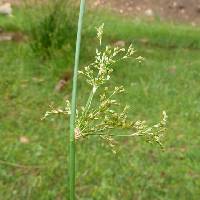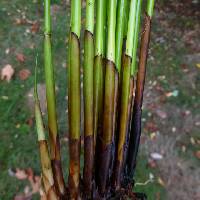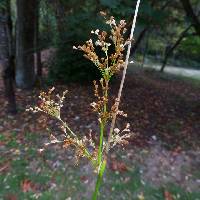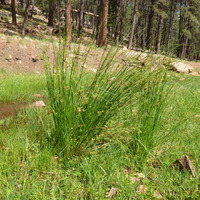Search
Juncus effusus
|
|
|
|
Family: Juncaceae
common rush
|
Herbs, perennial, 4--13 dm. Rhizomes short -branched, forming distinct, often large clumps. Culms erect, terete, 1--2.5 mm diam. at top of sheaths. Cataphylls several. Leaves: blade absent. Inflorescences lateral, compound dichasia, many flowered; primary bract erect, terete, extending well beyond dichasium. Flowers: tepals tan or darker, usually with greenish midstripe, lanceolate, 1.9--3.5 mm; inner slightly shorter; stamens 3, filaments 0.5--0.8 mm, anthers 0.5--0.8 mm; style 0.2 mm. Capsules greenish tan or darker, 3-locular, broadly ellipsoid to oblate, 1.5--3.2 mm. Seeds amber, (0.3--)0.4---0.5 mm. 2n = 40, 42. Flowering summer, fruiting summer--fall. Swamps and their edges, marshes, moist meadows, and moist or saturated soils, often conspicuous in pasture meadows where it is shunned by grazing animals; Habitat--; 0--2500 m; B.C., Man., N.B., Nfld. and Labr. (Nfld.), N.S., Ont., P.E.I., Que.; Ala., Alaska, Ariz., Ark., Calif., Colo., Conn., Del., D.C., Fla., Ga., Idaho, Ill., Ind., Iowa, Kans., Ky., La., Maine, Md., Mass., Mich., Minn., Miss., Mo., Mont., Nebr., Nev., N.H., N.J., N.Y., N.C., Ohio, Okla., Oreg., Pa., R.I., S.C., Tenn., Tex., Vt., Va., W.Va., Wash., W.Va., Wis. The Juncus effusus complex has been variously recognized as containing several species or a single species with numerous infraspecific taxa. Unfortunately, North American treatments have dealt primarily with taxa in either the eastern or western portions of the continent. In considering the continent as a whole, little sense can be made of these treatments. The North American J. effusus complex is one that is in obvious need of modern systematic scrutiny.
Perennial grasslike forb 40 cm - 1.3 m tall Leaves: none apparent since lacking blades (only having sheaths), though the basal sheath often very large. Inflorescence: a many-flowered, lateral (appears to spring directly from side of stem) cluster of branches from a single point, with each branch ending in a single, stalked, small, radially symmetric flower. The inflorescence is subtended by an erect bract which extends far beyond the inflorescence and appears to be a continuation of the stem. Individual flowers with two small bracts (bracteoles) directly below tepals. Stamens: three, with filaments and anthers about same length (0.5 - 0.8 mm). Pistil: with one superior ovary, a 0.2 mm long style, and three stigmas. Fruit: three-chambered, greenish tan or brownish, 1.5 - 3.2 mm tall, broadly ellipsoid to oval capsules. Stems: clustered, erect, smooth, round in cross section, 1 - 2.5 mm diameter, and arising from short, branching rhizomes. When dry, the stem has regular lengthwise ribs that extend for several centimeters without interruption. Seeds: many, amber, 0.3 - 0.5 mm long, somewhat elliptic, with short-pointed or abruptly narrowed tips, but without distinct narrowed tails at the ends. Tepals: six in two whorls of three, tan or brown, usually with greenish central stripe, 1.9 - 3.5 mm long (inner three slightly shorter than outer set), lance-shaped with pointed tips. Similar species: Juncus effusus is most easily confused with J. balticus var. littoralis, but that plant differs by having darker tepals, six stamens with the anthers much longer than the filaments, and the stems are well spaced in a long line along rarely branched rhizomes. Two other species which occur in northern Michigan, J. inflexus and J. filiformis, are quite similar, except both species have six stamens. Flowering: June to September Habitat and ecology: Somewhat common in marshy habitats. Occurence in the Chicago region: native Notes: This is another complex species which has been treated by others as several species or one species with several varieties. However, the treatments from North America need to be revised in terms of comparing all entities across the continent, as well as using modern systematic tools such as molecular and genetic information (Brooks and Clemants 2000). Author: The Field Museum Densely cespitose; stems to 1+ m, smooth or with 30-60 very low, inconspicuous ridges, the epidermal cells over the ridges not enlarged; basal sheaths to 2 dm, bladeless, mostly reddish-brown; invol lf (10-)15-25(-35) cm, appearing like a continuation of the stem; infl apparently lateral, many-fld, usually open, the longest branches (3-)4-10 cm; fls prophyllate; tep 2-2.5(-3) mm, stramineous, broadly lanceolate, acute, the outer commonly a bit longer than the inner; anthers 3; fr trilocular, slightly shorter to slightly longer than the tep, mostly obtuse to truncate, seldom J. griscomi) mucronate; 2n=40, 42. Open marshes and wet meadows; nearly cosmop., and throughout our range. Our common native plant, throughout e. U.S. and se. Can., is var. solutus Fernald & Wiegand, with rigid tep closely investing the fr. The European var. effusus, with soft tep ±spreading from the base, is locally intr. from Nf. to Me. and inland to Mich. and Minn. (Var. compactus, a form with compact infl) Gleason, Henry A. & Cronquist, Arthur J. 1991. Manual of vascular plants of northeastern United States and adjacent Canada. lxxv + 910 pp. ©The New York Botanical Garden. All rights reserved. Used by permission. FNA 2000, Kearney and Peebles 1969, Martin and Hutchins 1980 Common Name: common rush Duration: Perennial Nativity: Native Lifeform: Graminoid General: Perennial from short branched rhizomes, 40-130 cm tall, often forming distinct large clumps. Vegetative: Culms erect, terete, 1-2.5 mm in diameter at top of sheaths with several cataphylls; no leaf blades. Inflorescence: Lateral to stem, a compound cyme with opposite axes, many flowered; the primary bract is erect, terete, extending well beyond the cyme; tepals tan or darker with a greenish midstripe, lanceolate, 2-3.5 mm, inner slightly shorter, 3 stamens, filaments 0.5-1 mm, anthers same, style 0.2 mm; capsules greenish tan or darker, 3-locular, broadly ellipsoid to oblate, 1.5-3 mm. Ecology: Found in moist soils, in meadows, along marshes and stream edges from 2,000-8,500 ft (610-2591 m); flowers June-September. Notes: Distinguished by the cyme emerging lateral to the stem, along with being in large clumps. So big sometimes, you might confuse it with Schoenoplectus. Ethnobotany: Taken as an emetic, to prevent lameness in babies, ceremonially, as a forage for animals, the early sprouts were eaten, string, weaving mats and baskets,. Etymology: Juncus comes from the Latin jungere, to join or bind, while effusus means loosely spreading, straggling or spread out. Synonyms: Many, see Tropicos Editor: SBuckley, 2010 |






